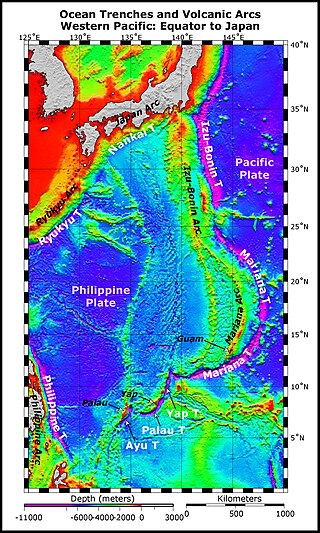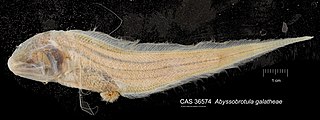
Trieste is a Swiss-designed, Italian-built deep-diving research bathyscaphe. In 1960, it became the first crewed vessel to reach the bottom of Challenger Deep in the Mariana Trench, the deepest point in Earth's seabed. The mission was the final goal for Project Nekton, a series of dives conducted by the United States Navy in the Pacific Ocean near Guam. The vessel was piloted by Swiss oceanographer Jacques Piccard and US Navy lieutenant Don Walsh. They reached a depth of about 10,916 metres (35,814 ft).

The Mariana Trench is an oceanic trench located in the western Pacific Ocean, about 200 kilometres (124 mi) east of the Mariana Islands; it is the deepest oceanic trench on Earth. It is crescent-shaped and measures about 2,550 km (1,580 mi) in length and 69 km (43 mi) in width. The maximum known depth is 10,984 ± 25 metres at the southern end of a small slot-shaped valley in its floor known as the Challenger Deep. The deepest point of the trench is more than 2 km (1.2 mi) farther from sea level than the peak of Mount Everest.

The snailfishes or sea snails, are a family of marine ray-finned fishes. These fishes make up the Liparidae, a family classified within the order Scorpaeniformes.
The abyssal zone or abyssopelagic zone is a layer of the pelagic zone of the ocean. The word abyss comes from the Greek word ἄβυσσος (ábussos), meaning "bottomless". At depths of 4,000–6,000 m (13,000–20,000 ft), this zone remains in perpetual darkness. It covers 83% of the total area of the ocean and 60% of Earth's surface. The abyssal zone has temperatures around 2–3 °C (36–37 °F) through the large majority of its mass. The water pressure can reach up to 76 MPa.
The hadal zone, also known as the hadopelagic zone, is the deepest region of the ocean, lying within oceanic trenches. The hadal zone ranges from around 6 to 11 km below sea level, and exists in long, narrow, topographic V-shaped depressions.

The Kermadec Trench is a linear ocean trench in the south Pacific Ocean. It stretches about 1,000 km (620 mi) from the Louisville Seamount Chain in the north (26°S) to the Hikurangi Plateau in the south (37°S), north-east of New Zealand's North Island. Together with the Tonga Trench to the north, it forms the 2,000 km (1,200 mi)-long, near-linear Kermadec-Tonga subduction system, which began to evolve in the Eocene when the Pacific Plate started to subduct beneath the Australian Plate. Convergence rates along this subduction system are among the fastest on Earth, 80 mm (3.1 in)/yr in the north and 45 mm (1.8 in)/yr in the south.

Trimethylamine N-oxide (TMAO) is an organic compound with the formula (CH3)3NO. It is in the class of amine oxides. Although the anhydrous compound is known, trimethylamine N-oxide is usually encountered as the dihydrate. Both the anhydrous and hydrated materials are white, water-soluble solids.

The Izu–Ogasawara Trench, also known as Izu–Bonin Trench, is an oceanic trench in the western Pacific Ocean, consisting of the Izu Trench and the Bonin Trench.

Pseudoliparis amblystomopsis, or the hadal snailfish, is a species of snailfish from the hadal zone of the Northwest Pacific Ocean, including the Kuril–Kamchatka and Japan Trenches.

Abyssobrotula galatheae is a species of cusk eel in the family Ophidiidae. It is the deepest-living fish known; one specimen, trawled from a depth of 8,370 m (27,460 ft) in the Puerto Rico Trench in 1970, holds the record for the deepest fish ever captured. Although generally recognized, some have suggested that the record-breaking individual might have been caught with a non-closing net and therefore perhaps caught shallower.
Notoliparis kermadecensis is a species of snailfish (Liparidae) that lives in the deep sea. Endemic to the Kermadec Trench in the Southwest Pacific, it is hadobenthic with a depth range between 6,474 and 7,561 m (21,240–24,806 ft), and can reach a standard length of up to 25.8 cm (10.2 in).

Paraliparis is a genus of fish in the family Liparidae, the snailfishes. It is found in benthic, benthopelagic and pelagic habitats in all the world's oceans.
Notoliparis is a genus of marine ray-finned fish belonging to the family Liparidae, the snailfishes. These fishes are found in deep Oceanic trenches in the South Atlantic South Pacific and Southern Oceans.

Careproctus is a genus of snailfishes found in benthic and benthopelagic habitats in the Atlantic, Pacific, Arctic and Southern Oceans. Whether they truly are absent from the Indian Ocean is unknown and might be an artifact of limited sampling. They range from shallow coastal seas in the far north of their range to the abyssal zone, at depths of 6 to 5,459 m (20–17,910 ft). In the Northern Hemisphere they mostly live shallower than Paraliparis, but this pattern is reversed in the Southern Hemisphere. Although almost entirely restricted to very cold waters, a single species, C. hyaleius, lives at hydrothermal vents.
Genioliparis is a genus of marine ray-finned fishes belonging to the family Liparidae, the snailfishes. These fishes are found in the Pacific and Southern Oceans.

Pseudoliparis swirei, the Mariana snailfish or Mariana hadal snailfish, is a species of snailfish found at hadal depths in the Mariana Trench in the western Pacific Ocean. It is known from a depth range of 6,198–8,076 m (20,335–26,496 ft), including a capture at 7,966 m (26,135 ft), which is possibly the record for a fish caught on the seafloor. Various anatomical, physiological, molecular and genetic adaptions help this species survive in such depths.

Eurythenes plasticus is a species of amphipod of the genus Eurythenes, first described in 2020. It was named in reference to the PET plastic found in its stomach, after researchers wanted to highlight the impact of plastic pollution.

Alan John Jamieson is a Scottish marine biologist, engineer, explorer and author, best known for his deep-sea exploration and study of life at the deepest places in the oceans. He is known for extensive use of deep-sea landers to establish the maximum depth and community dynamics of many organismal groups, as well as the discovery of many new species and highlighting the presence of anthropogenic impacts at full ocean depth. During the Five Deeps Expedition, and follow on expeditions in 2020, he completed various dives in a manned submersible to some of the deepest places in the world. He has published over 100 scientific papers and participated in 65 deep-sea expeditions.

Paraliparis selti, the blue Atacama snailfish, is a species of deep water snailfish that is native to the south-east Pacific Ocean hadal zone 6,714 meters under water in the Atacama Trench. P. selti is 83 millimeters in length total and 75.9 millimeters in standard length. its one of the 200 species of snailfish discovered in the southern hemisphere.
Pseudoliparis belyaevi is a species of snailfish found in hadal zone of the Northwest Pacific Ocean, particularly the Japan Trench.














